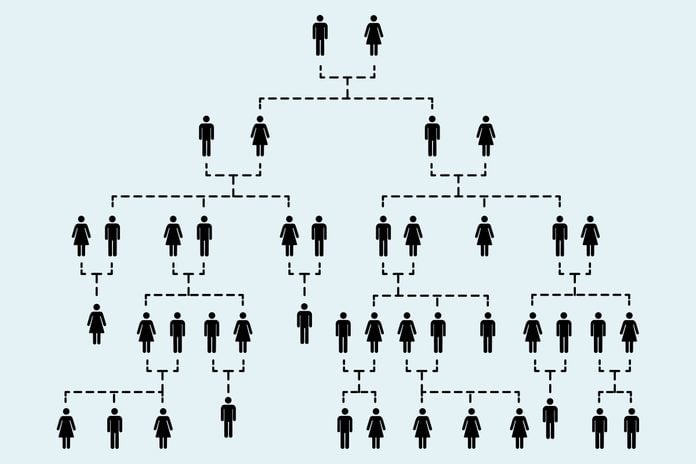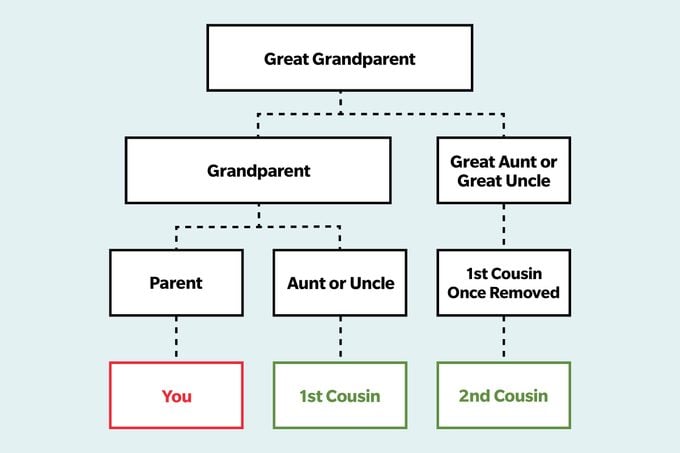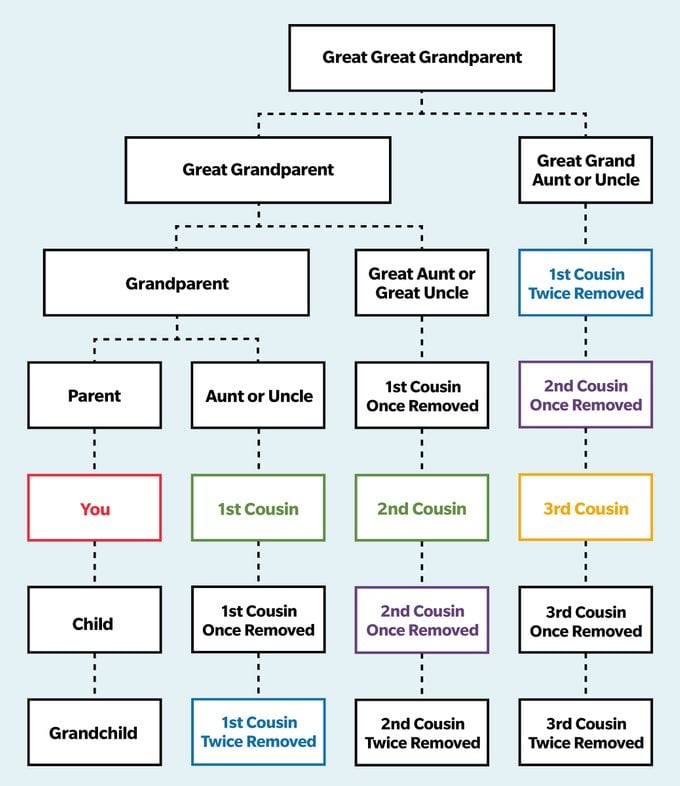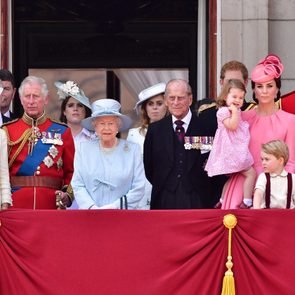What’s a Second Cousin vs. Second Cousin Once Removed?
Updated: Apr. 21, 2021

If Bill is your second cousin once removed, is he your great-grandparent's cousin or nephew? Find out with our handy cousin chart!
They say family is the most important thing there is, and we are inclined to agree. Figuring out who’s actually in your family, however, is a whole different ballgame. If you’re like us, meeting long-lost cousin Bill at your family reunion is nice and all, but hearing he’s your “second cousin once removed” leaves you just as confused as ever. Sure, he’s a cousin, but is he blood-related? Maybe on your dad’s side. Or could he actually be your uncle? Who really knows!
Well, now you’ll know, thanks to this handy dandy family tree chart. We’ve also laid it out clearly below with explanations of each family label, and even included a downloadable chart so that you can put second cousin Bill on his proper tree branch. And as a bonus, you’ll finally have a good reason to use the word “thrice.” If you want to dig even deeper into your family tree, genealogy websites like familytreenow are a great resource. For your ethnic heritage, home DNA tests can be an illuminating way to find out where your ancestors were from, although it’s wise to take results with a grain of salt as many of these companies are not regulated. But either way, once you’ve discovered your new cousins you’ll need a way to figure out where they fall in relation to you! Enter our helpful cousin categorizing chart.

Who are your first cousins?
Family members who are considered first cousins share grandparents with you. If your mom or dad have siblings, and those siblings have children, the kids are your first cousins! To your mom and dad, they’re nephews and nieces, but to you, they’re first cousins. Often these are the relatives people mean when they say, “she’s my cousin.” If they’re not adopted, you share about 1/8 of your DNA with your first cousins!
So what are second cousins?
Second cousins have the same great-grandparents as you. Think of it this way: your mom’s first cousin’s child is your second cousin. Or, your grandpa’s brother’s grandchild (your dad’s aunt’s grandchild) is your second cousin. You’re in the same generation, they’re just not as closely related.

What about a second cousin once removed?
A cousin once removed means they’re from the generation immediately above or below you. So your first cousin once removed would be your first cousin’s child or your parent’s first cousin. Your second cousin once removed is your second cousin’s child or your parent’s second cousin.
So a cousin twice removed is…?
“Twice removed” means that there’s a two generation gap: this cousin is from either your grandparents’ generation, or your grandchild’s generation. So your first cousin twice removed would be your grandparent’s first cousin or your first cousin’s grandchild. Your second cousin twice removed is your second cousin’s grandchild or your grandparents’ second cousin.
And what about third cousins?
Third cousins share the same great-great-grandparents! Your third cousin is your mom’s great aunt’s great-grandkid. OK, that’s a little confusing. How about this: your great-great-uncle’s great-grandchild is your third cousin. You might need another look at the chart. Or you can just call them “cousin.”
There’s a hack to remember which cousin is which
First, second, and third cousins (and so on unto infinity cousins) are an equal number of generations removed from the common ancestor. First cousins are both the second generation removed from their shared grandparents. Second cousins are the third generation removed from shared great-grandparents. So: cousin plus one is the number of generations back.
So “grand” doesn’t mean cousins?
The word “grand” means that there’s a two-generation gap between the people: your brother’s grandchild is your grand-niece, and your mom’s father is your grandfather. There is an exception: Your parents’ sibling is your aunt or uncle, but your parents’ aunt or uncle is usually referred to as a great-aunt or -uncle, despite the two-generation gap rule. Grand-aunt just sounds a bit weird.
But “great” usually goes with “grand”?
The use of “great” is usually paired with grand, and it means that there is a three-generation gap between you and your relative. Your niece’s grandchild is your great-grandniece or -nephew, and your grandkid’s kid is your great-grandchild! Of course, there’s another exception for aunts and uncles: Your mom’s uncle is your great-uncle, but your mom’s great-uncle is your great-great-uncle.
How to organize your cousins
Even with the chart and the explanations above, it can be hard to map a concept like “second cousin thrice removed” onto real-life Maureen, who you know only as making the best potato salad at the family reunion. So we’ve created a family tree chart for you to download, print, and fill in with your family’s names! It’s also the perfect ice breaker for your next family Thanksgiving. You might even find a new family member or two.
Sources:
- Lifehacker: “Second Cousins Once Removed”


